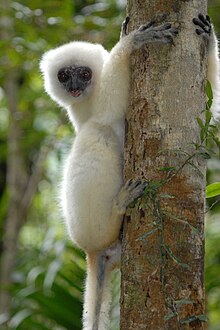Silky sifaka
| Silky sifaka | |
|---|---|
 |
|
| Scientific classification | |
| Kingdom: | Animalia |
| Phylum: | Chordata |
| Clade: | Synapsida |
| Class: | Mammalia |
| Order: | Primates |
| Suborder: | Strepsirrhini |
| Family: | Indriidae |
| Genus: | Propithecus |
| Species: | P. candidus |
| Binomial name | |
|
Propithecus candidus A. Grandidier, 1871 |
|
 |
|
| Distribution of P. candidus | |
| Synonyms | |
|
|
The silky sifaka (Propithecus candidus), or silky simpona, is a large lemur characterized by long, silky, white fur. It has a very restricted range in northeastern Madagascar, where it is known locally as the simpona. It is one of the rarest mammals on Earth, and is listed by the International Union for Conservation of Nature (IUCN) as one of the world's 25 most critically endangered primates. The silky sifaka is one of nine sifaka species (genus Propithecus), and one of four former subspecies of diademed sifaka (P. diadema). Studies in 2004 and 2007 compared external proportions, genetics, and cranio-dental anatomy supporting full species status, which has generally been accepted.
The silky sifaka has a variable social structure, and lives in groups of two to nine individuals. It spends most of its day feeding and resting, though it also devotes a considerable amount of time to social behaviors, such as playing and grooming, as well as traveling. Females occasionally take priority over males during feeding. Like other eastern sifakas, it consumes mainly leaves and seeds, but also fruit, flowers, and even soil on occasion. It is a seasonal breeder and only mates one day a year during the start of the rainy season. As with other sifaka species, non-maternal infant care is common. Group members of all ages and both sexes will often groom, play with, occasionally carry, and even nurse infants that are not their own. The silky sifaka vocalizes frequently despite its moderately sized vocal repertoire consisting of seven adult calls. Like all other lemurs, it relies strongly on scent for communication. Males will frequently scent-mark on top of scent-marks made by other group members, particularly females. Males also gouge trees with their toothcomb (a special arrangement of the bottom, front teeth) prior to chest scent-marking. This chest marking results in males having brown-stained chests, the only visible trait that can be used to distinguish between adult males and adult females.
...
Wikipedia

